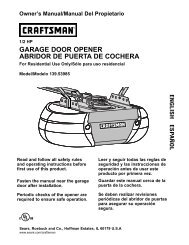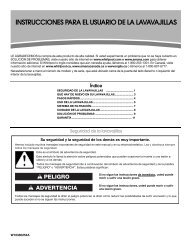Sewing Machine - Brother
Sewing Machine - Brother
Sewing Machine - Brother
Create successful ePaper yourself
Turn your PDF publications into a flip-book with our unique Google optimized e-Paper software.
—————————————————————————————————————————————————————————————————————————————————————————————————————————————————————<br />
Incorrect thread tension<br />
■ Symptoms<br />
Symptom 1: The lower thread is visible from the upper side of the fabric.<br />
Symptom 2: The upper thread appears as a straight line on the upper side of the fabric.<br />
Symptom 3: The upper thread is visible from the lower side of the fabric.<br />
Symptom 4: The lower thread appears as a straight line on the lower side of the fabric.<br />
Symptom 5: The stitching on the lower side of the fabric is loose or has slack.<br />
Symptom 1 Symptom 3<br />
■ Cause/remedy/check details<br />
Cause 1<br />
The machine is not correctly threaded.<br />
<br />
The lower threading is incorrect.<br />
Return the upper tension-control dial to “4”,<br />
and then refer to “Upper thread tightened up”<br />
(page 89) to correct the threading.<br />
<br />
The upper threading is incorrect.<br />
Return the upper tension-control dial to “4”,<br />
and then refer to “Tangled thread on wrong<br />
side of fabric” (page 90) to correct the upper<br />
threading.<br />
Cause 2<br />
A needle and thread appropriate for the<br />
fabric are not being used.<br />
The sewing machine needle that should be<br />
used depends on the type of fabric sewn and<br />
the thread thickness.<br />
If a needle and thread appropriate for the<br />
fabric are not being used, the thread tension<br />
will not be adjusted correctly, causing<br />
wrinkles in the fabric or skipped stitches.<br />
Refer to “Needle types and their uses”<br />
(page 29) to check that a needle and thread<br />
appropriate for the fabric are being used.<br />
Cause 3<br />
An appropriate setting on the upper tension-control dial is not selected.<br />
Turn the upper tension-control dial to select an appropriate thread tension.<br />
The appropriate thread tension differs according to the type of fabric and thread being used.<br />
* Adjust the thread tension while test sewing on a piece of scrap fabric that is the same as that used in<br />
your project.<br />
Note<br />
● If the upper threading and lower threading are incorrect, the thread tension cannot be adjusted<br />
correctly, even by turning the upper tension-control dial. Check the upper threading and lower<br />
threading first, and then adjust the thread tension.<br />
When the lower thread is visible from the<br />
upper side of the fabric. Turn the upper<br />
tension-control dial to a lower number<br />
(toward the left). (Loosen the thread tension.)<br />
5<br />
4 3<br />
a Lower side of fabric<br />
b Lower thread visible from<br />
upper side of fabric<br />
c Upper thread<br />
d Upper side of fabric<br />
e Lower thread<br />
f Upper thread visible from<br />
lower side of fabric<br />
When the upper thread is visible from the<br />
lower side of the fabric. Turn the upper<br />
tension-control dial to a higher number<br />
(toward the right). (Tighten the thread<br />
tension.)<br />
5<br />
4 3<br />
93<br />
4
















